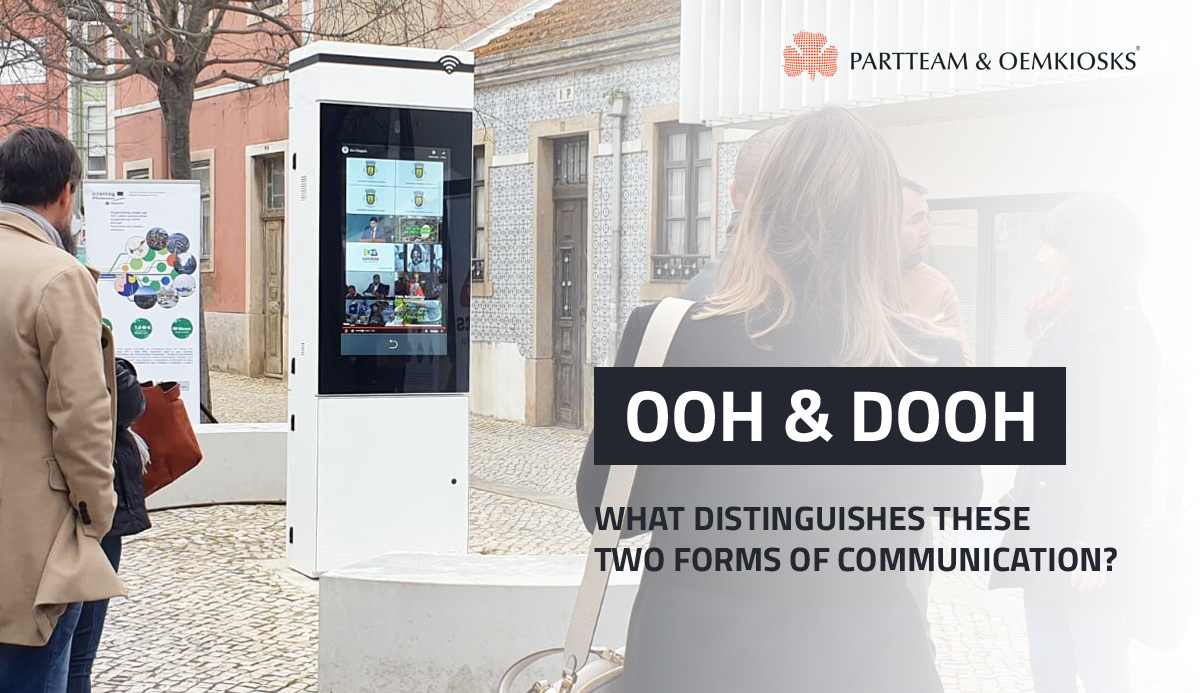OOH and DOOH: What distinguishes these two forms of communication?
OOH, DOOH, Smart Cities, Proof of Play, Programmatic Advertising, Digital Billboards, Interactive Tables, Multimedia Kiosks
With digitization and technological evolution, there has been a sharp growth in DOOH (Digital-Out-of-Home, which refers to advertising used for commercial purposes, usually located in public places, which may involve screens and other digital and interactive tools). However, it is important to understand the differences between DOOH and OOH (Out-of-Home, that is, static advertising that attracts the consumer while in public places), which will be explained in this article.
DOOH, as the name implies, refers to digital media found in public places for advertising or informational purposes. They are generally installed in places of intense traffic and urban movement, with high capacity for attention and persuasion of the surrounding public. For this purpose, several digital or interactive devices are used, namely digital billboards, multimedia kiosks and interactive tables.
OOH refers to all external advertising communication, considered the traditional communication. Although influential, it achieves less results than DOOH.
Nevertheless, what matters when choosing OOH or DOOH communication is the purpose of the campaign: “do I want to use static or digital advertising?”.
DOOH (Digital-Out-of-Home)
DOOH is ideal when brands want to reverse an impacting campaign in a short time or when they want to respond to breaking news. The possibility of spreading messages in real time is one of the main advantages of DOOH communication.
With the introduction of new technologies, the use of digital billboards in different places became even more interesting. And so, DOOH communication emerged.
Reaching specific market segments, enjoying the benefits of technology, marketing to a large number of people in a dynamic, flexible way and without contributing to visual pollution are some of the characteristics of DOOH campaigns.
OOH (Out-of-Home)
The main goal of OOH communication is to reach people when they walk along streets, avenues, highways or public spaces, such as squares, shopping centers, parks and exhibitions. This type of advertising has become more popular, as people also spend more time away from home.
Although this concept is related to massification, it can be used locally. Through the use of posters and billboards placed in specific places, the process becomes simpler, as there is already an expected audience profile that may be interested in the product or service advertised.
The differences
The main differences between these two forms of advertising are, above all, the messages they are intended to convey, the ease of purchase, interactivity and the benefits of each. Here are some examples.
Messages
Considering the fact that everyone can access the news in real time, it is important to emphasize that OOH communication cannot be updated as easily as DOOH communication. Therefore, the OOH message has, nowadays, to be thought in such a way that it doesn’t become obsolete and uninteresting for those who see it.
This way, and due to the real-time nature of a DOOH campaign, ads can be quickly adjusted in response to events, which saves time and money.
Ease of purchase
Given the ease and accuracy of messages, DOOH communication is more compatible with digital marketing campaigns than OOH communication. Consequently, DOOH purchase becomes more convenient.
Thus, there is a merger of the physical with the digital, which ultimately highlights the use of DOOH campaigns.
These statements are justified by new methods of measuring audiences, which are, in turn, increasingly accurate. Traditionally, OOH campaigns have not been able to measure accurate results for pedestrian traffic or increased sales.
Interactivity
Taking into account the technological evolution, there is a growing interest in interactive solutions. Therefore, there is a greater investment in DOOH communication, since in addition to providing greater involvement of users, it presents multimedia content such as animation, video, audio. All this implies an immersive interaction, which will create more impact on the user.
Benefits
Although we are facing two distinct forms of communication, both have their advantages.
Thus, DOOH advertising stands out for the following factors:
- More attractive interactions for the consumer;
- It does not require large investments;
- Intersection between mobile devices, Internet and social networks;
- Flexible, real-time campaigns that fit the target audience;
- Reach the public at any time and anywhere;
- Contents displayed in high quality;
- Advertisements aimed at specific market segments;
- Great potential to attract attention and involve the target audience;
- Promotion of ads with several formats, which end up being more efficient than static ads;
- Instant access to more product information;
- Remote content management;
- Ability to ensure Proof of Play;
- Audience measurement.
OOH advertising also has its benefits:
- More affordable prices;
- No sharing of billboards with other advertisers;
- Great reach – millions of people circulate in the same places every day and, no matter how distracted they are by their commitments, it is undeniable the impact these messages have when their paths cross;
- Power of impact – at a time when there are blockers of advertisements on the Internet accessible to all, external advertising appears as an alternative for brands to be present in people’s daily lives;
- Efficient for mass dissemination or for segments.
Programmatic advertising
Programmatic advertising is a concept that includes several technologies that automate a purchase, the positioning and optimization of advertising, performed in real time and with different levels of control and automation. The main objective is the replacement of human activities in the negotiation of advertising spaces.
This way, programmatic advertising is increasingly present in our daily lives, namely through digital billboards (DOOH).
In fact, DOOH programmatic advertising has the following benefits:
- Possibility of micro-public segmentation;
- Ease of workflow;
- Opportunity for OOH advertising professionals to program on digital, taking advantage of digital budgets.
